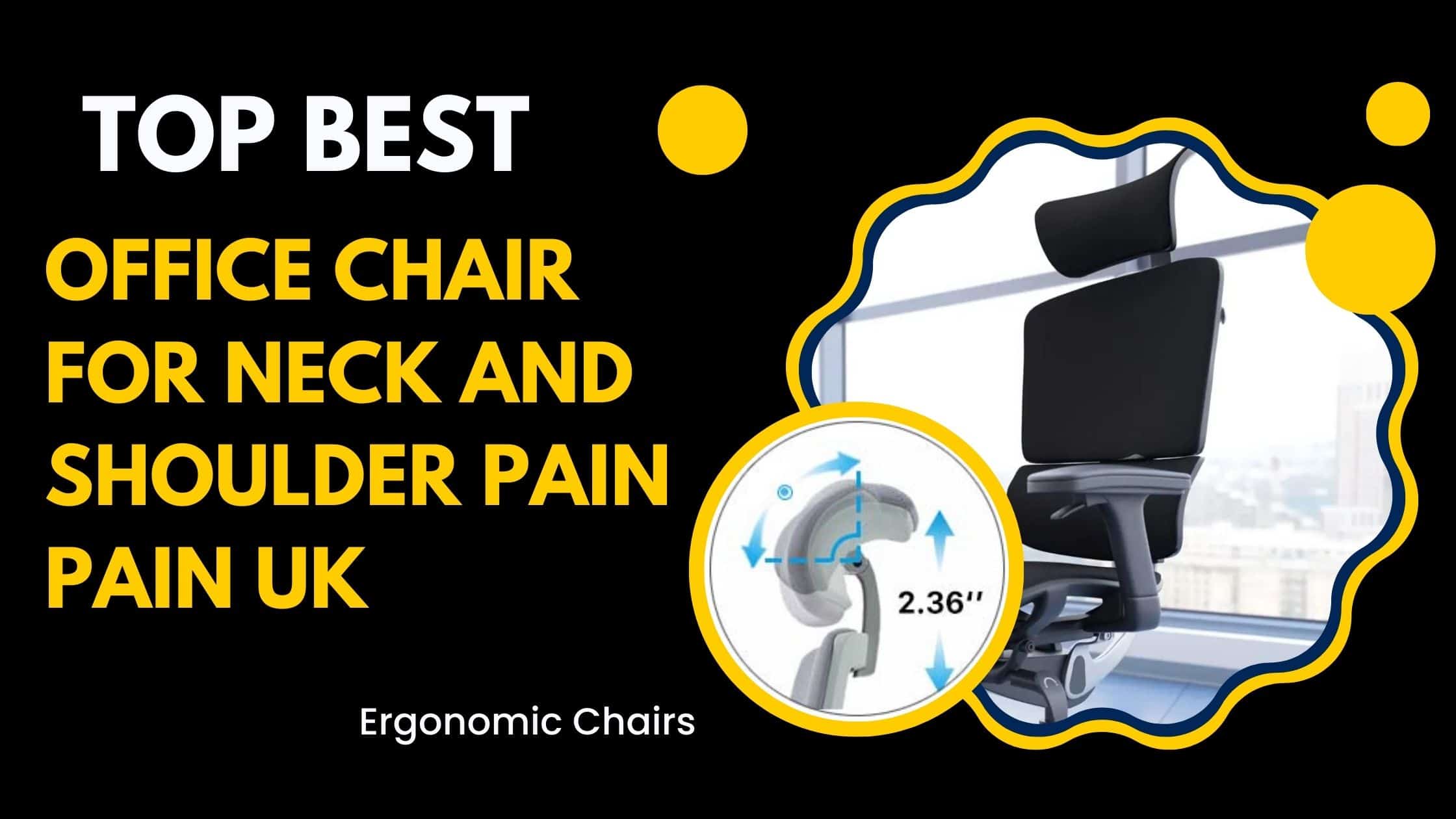This article is on the topic of the best office chair for neck and shoulder pain problems written by ergonomic experts.
Many individuals, including myself, have experienced the nagging pain caused by improper office chairs. A poorly designed chair, lacking a headrest or placed in an awkward position, can lead to significant strain on the cervical spine, resulting in persistent neck discomfort over time. Frustrated with this issue, I embarked on a quest to find the best office chair for neck and shoulder problems. After testing and trying out various options for several weeks, I can confidently share my personal perspective on the most effective solution.
In my pursuit of a suitable office chair, I researched and evaluated over 40 different models featured in numerous buyer’s guides. My primary goal was to find chairs that not only provided excellent neck support but also met other crucial criteria for a fantastic ergonomic chair. Through this process, I aimed to address my persistent neck and shoulder pain and create a comfortable and productive workspace.
Stay tuned as I share my personal journey and discoveries, guiding you through the selection process of the best office chair for neck and shoulder pain. From ergonomic design to adjustable features, I will shed light on the factors that matter most and help you find the perfect chair to support your neck and shoulder health.
Let’s look at our first-hand experience review alongside recent buyer sayings.
| Flexispot Ergonomics | Today’s Discount Deal |
Read: Best Office Chair For Back Pain: Rejoice Relief Solution!
Best Office Chair For Neck And Shoulder Pain Problems At A Glance
| Office Chairs | Neck Adjustable | Buyer Satisfaction Ratings | Stores |
|---|---|---|---|
| KERDOM 968 For Neck Problems (Recommend) | Manual, Height | 86% | Low Price Offer |
| M57 Ergonomic (Recommend) | Manual, height, and depth adjustable | 86% | Low Price Offer |
| Hbada E1 Home Office | Angle, Height | 84% | Low Price Offer |
| Dripex For Neck Pain | Height, Angle | 88% | Low Price Offer |
| Executive For Neck And Shoulder Pain | Fixed | 90% | Low Price Offer |
| HUANUO For Upper Back And Neck Pain | Height, Angle | 84% | Low Price Offer |
| Duwin Neck Shoulder Pain (Recommend) | Manual, Height, Angle | 86% | Low Price Offer |
Superior Head and Neck, Shoulder Comfort
Let’s talk about something that’s close to my heart – head and neck, shoulder support. It is where ergonomic office chairs come into play, offering two main types of neck support.
The first type I encountered was the fixed headrest, stretching across the entire backrest. I found this design commonly in executive office chairs, featuring a cushioned pillow that can be quite cozy if adjusted at the right height. However, it didn’t entirely meet my needs, as my neck discomfort required a more customized solution.
That’s when I discovered the magic of an articulated headrest. Unlike the fixed variety, this headrest is flexible and shaped to match the curve of your cervical spine. It’s like having a tailor-made support system for your neck. If you, like me, struggle with neck discomfort, the key here is to ensure that the articulated headrest is adjustable in height. This adjustability allows you to target the specific region of your neck that needs extra support, providing maximum relief.
During my search for the perfect office chair, I quickly learned that the right head and neck, also wider backrest support could be a lifesaver for those with neck and shoulder issues. It’s crucial to ensure that any articulated headrest is height adjustable, allowing it to cater precisely to the area that needs relief.
Optimal Seat Height
I learned that having a sturdy seat height control is essential for preventing neck strain. Following the recommendations of the Occupational Safety and Health Administration (OSHA), I aimed for a seat height adjustment range of 15 to 22 inches. This range allowed me to customize the chair’s height to fit my body perfectly, creating a more ergonomic and comfortable setup.
In the past, I experienced neck aches due to incorrect seat height. When my workstation was too high, I found myself elevating my shoulders and raising my hands, wrists, and forearms to compensate. This unnatural position caused strain on my neck muscles and even led to headaches when the suboccipital muscles at the base of my skull became exhausted.
Conversely, when my desk was too low, my neck and upper torso would bend forward, shortening my suboccipital muscles. This poor posture resulted in migraines, neck pain, and muscular spasms, making it almost impossible to focus on my work.
But with the right seat height adjustment, I finally found the sweet spot for my comfort. My shoulders relaxed, and my hands rested naturally on the desk. This proper alignment significantly reduced the strain on my neck muscles and eliminated the headaches and neck pain that had plagued me for so long.
Dynamic Lumbar
I learned that the natural curvature of the lower section of the spine, known as the lordotic curve, is crucial for maintaining proper posture. A good lumbar support fills the gap between the backrest and the spine, preventing slouching and avoiding a forward head position. It was evident to me that the right lumbar support not only addressed neck discomfort but also played a vital role in relieving shoulder pain.
During my exploration of office chairs, I came across three types of lumbar support options. The fixed lumbar support, found on lower-end chairs, couldn’t be adjusted to fit my needs better. I needed something more customizable, which led me to the adjustable lumbar support. This option allowed me to manually alter the height, depth, or stiffness of the support, providing a better fit.
However, it wasn’t until I discovered dynamic lumbar support that I experienced true comfort and relief. This innovative feature automatically adjusts its depth and hardness based on my sitting position. It was like having a personalized support system that adapted to my body’s needs, ensuring that my spine stayed in its natural alignment throughout the day.
In my case, the ideal lumbar support depth ranged from 0.6 to 2 inches, which helped me maintain proper posture and avoid discomfort. I also learned that women typically have a more pronounced lordotic curve, making an office chair with deeper lumbar support an excellent choice for them. Additionally, if you’re tall, opting for higher lumbar support can be beneficial.
Adaptable Armrests
I discovered that improper arm support or poorly placed arms while working could lead to shoulder pain, which in turn affected my neck. It was a domino effect that I hadn’t realized until I paid closer attention to my posture. The key to finding relief was achieving the right arm posture, where my forearms were parallel to the desk, and my elbows formed a 90-100 degree open angle. In this position, my arms and shoulders were at their most relaxed state, and I felt the strain on my neck lessen.
My quest for an ergonomic office chair led me to the importance of adaptable armrests. I learned that at least 2D armrests, meaning height-adjustable armrests, were crucial to achieving the optimal arm posture. With the ability to adjust the armrests to the right height, I could finally find the perfect fit for my arms and shoulders, reducing the strain on my neck significantly.
Best Office Chair For Neck And Shoulder Pain Problems: Tried And Tested
Why you can trust Best Ergonomic Office Chairs UK: Our expert reviewers spend hours testing and comparing products and services so you can choose the best for you. Find out more about how we test.
1. KERDOM 968 Ergonomic Office Chair For neck Problems
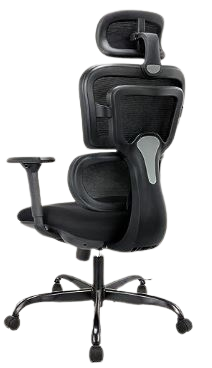
Considering neck problems, give the KERDOM 968 Ergonomic Office Chair for neck problems a try.
I had heard great things about its ergonomic design, which claimed to fully support the neck, and shoulder, offering long-term comfort and optimal support.
Upon assembling the chair, which was a breeze thanks to the included tools, I was immediately impressed by its sturdiness and modern appearance.
After testing for several weeks, the most appreciated feature for me was the dynamic neck support that holds the cervical spine. With multiple adjustment levels, I could easily customize the support for my shoulder and neck. The chair’s ability to cradle my neck precisely where I needed it was a game-changer in alleviating my neck discomfort.
See the picture below of our first hand experience, package arrival at home.
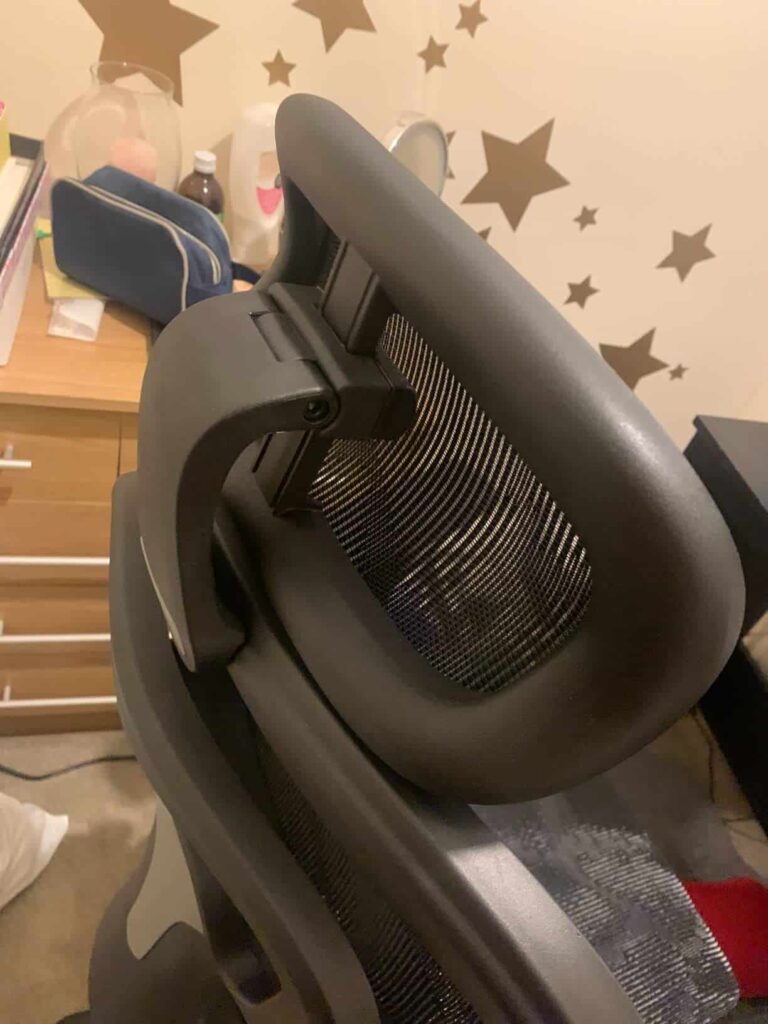
if you are someone taller than 6 feet, you may find that the headrest was a little low for liking, but it didn’t significantly impact my overall comfort. The rest of the chair provided ample support and relief for my neck problems.
Over the weeks of using the KERDOM 968, I noticed a significant improvement in my neck pain. The chair’s design forced me to sit with the correct posture, reducing strain and discomfort. It took a bit of getting used to, especially as I had to break old habits, but the results were worth it.
Overall, the KERDOM 968 Ergonomic Office Chair proved to be a lifesaver for my neck problems.
2. M57 Ergonomic Office Chair For Neck Pain
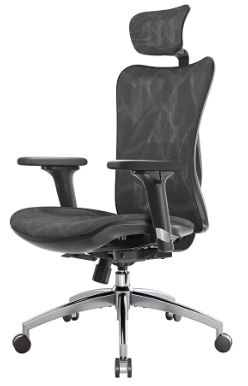
If you’re on a budget but in need of an ergonomic office chair with proper neck support, let me introduce you to the SIHOO M57.
The M57 proved to be a pleasant surprise. Its headrest, often underestimated, offered excellent neck support for individuals of varying heights, including those up to 6’3″. The contoured shape and customizable height and angle adjustments made it the ideal companion for sitting.
Beyond its neck support, the chair’s cushioned armrests were a delight to use, adding to its overall comfort. The cool mesh backrest and gently curved foam seat contributed to a pleasant sitting experience, while the rollerblade wheels made moving around effortless, even on hardwood surfaces.
The S-shaped backrest, designed to mimic the human spine, provided comprehensive cervical vertebral pressure support, which was crucial for neck pain relief. The adjustable headrest, in combination with the lumbar support, gave long-term comfort and optimal support, keeping health-conscious during extended work sessions.
See the picture below of our first hand experience, package arrival at home.
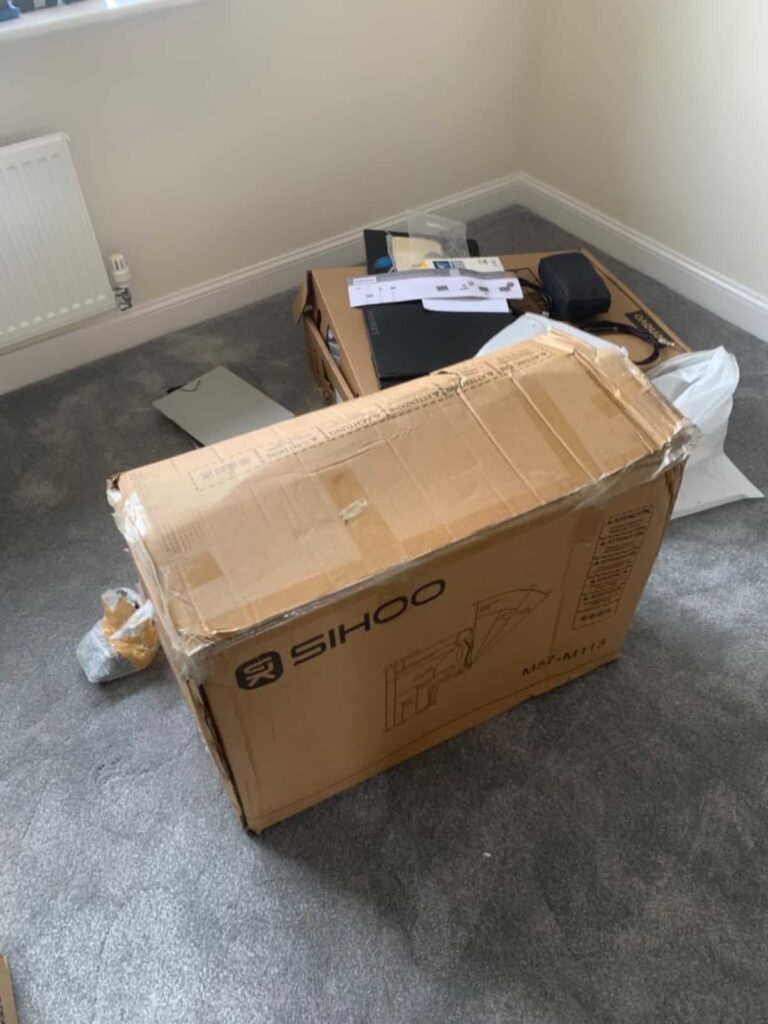
As I delved into customer reviews, I noticed praise for the chair’s ability to alleviate Shoulder pain for several users. The chair received numerous positive comments.
Nonetheless, the majority of customers, including myself, found the M57 to be an unbeatable value. It serves as a fantastic budget pick for those seeking an ergonomic office chair that supports neck and back health without breaking the bank.
Overall, the SIHOO M57 Ergonomic Office Chair offered me the much-needed neck pain relief I sought. Its adjustable features, including the headrest, armrests, and shoulder support, made it a wise investment.
3. Hbada E1 Home Office Chair For Neck Pain
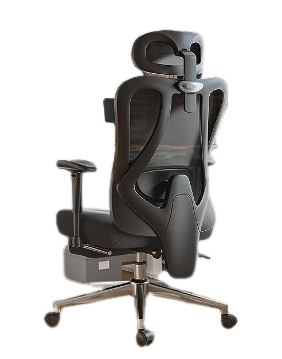
I decided to give the Hbada E1 Home Office Chair a try to find relief. I read several positive reviews about its comfort and adjustability, which piqued my interest.
Upon receiving the chair, I was pleased with its overall design and build quality. It was straightforward to assemble, taking about 20 minutes to set up.
The first thing that caught my attention was the chair’s textured appearance, giving it a sense of proportion and elegance. The headrest and lumbar support provided excellent cushioning and were designed to support the cervical and lumbar spine, wrapping around me comfortably. For someone like me with a history of back issues, this was a blessing.
The chair offered a range of adjustments, allowing me to customize it to my specific needs. The footrest was a nice addition, and I found it to be quite usable despite some users mentioning its weakness. The armrests, however, had a minor downside as they easily rotated and lacked a locking mechanism. Additionally, they felt a bit short when I leaned backward, and there was no armrest area to support my arms.
On the positive side, the chair was incredibly stable and didn’t wobble while I sat, ensuring a secure and steady experience. The headrest, footrest, and back adjustment functioned well, providing me with a comfortable sitting position.
I must admit that while the Hbada E1 Home Office Chair was more comfortable than my previous chair, it wasn’t as exceptional as some other high-end options I’ve tried. I found that I needed to purchase a foam cushion for extra comfort during extended sitting periods.
Overall, the Hbada E1 Home Office Chair is a good and well-built option, but it may not be perfect for everyone. Its adjustability and solid construction make it a decent choice, especially for those on a budget. While it may not completely resolve all neck pain issues, it does offer a comfortable and supportive seating experience. The chair’s stability and adjustability make it an excellent option for home office use.
4. Dripex 1 Office Chair For Neck Pain
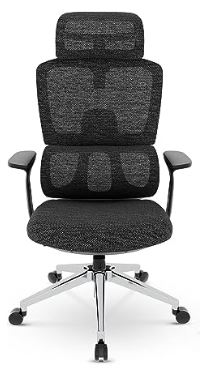
The chair had promising features, including an adjustable headrest and lumbar support, making it an attractive option.
Upon receiving the chair, I was pleased with its appearance and build quality. The headrest, along with the back, was made of mesh material, ensuring good ventilation and keeping me cool even during hot summer days or extended use. The headrest’s height and angle adjustments allowed me to find a comfortable neck position in various sitting postures.
The chair’s adjustable features extended to the seat, which provided ample support for different heights and builds. The back of the chair was designed to tilt and recline, accommodating a variety of sitting preferences. I found that the chair’s swivel and height adjustment added to its overall comfort and practicality.
One notable advantage was that the Dripex 1 Office Chair came with rollerblade wheels, which were gentle on hardwood floors, eliminating the need for separate caster purchases.
The chair received positive reviews for its adjustability and quality. I found the chair to be a good quality option, especially considering its price. The lumbar support and adjustable headrest were particularly beneficial for my neck pain relaxation.
5. Executive Office Chair For Neck And Shoulder Pain
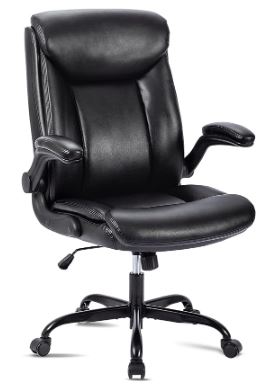
After trying out the executive office chair for neck and shoulder pain, I must say that it exceeded my expectations in terms of comfort and build quality. The chair felt solid and well-made, providing me with the support I needed for my neck and shoulder pain.
Assembling the chair was a breeze, thanks to the clear and precise assembly instructions. Once set up, I found the chair to be very comfortable, with the fabric material providing a soft and almost denim-like feel. The ergonomic design of the chair offered excellent back support, making long hours of work more bearable.
One standout feature was the flexibility of the chair’s arms, which could be lifted up, providing easy access for getting in and out of the chair. The five feet with rollers allowed for smooth movement and added to the overall convenience of the chair.
I also appreciated the attention to detail in the packaging, ensuring that all parts were well-organized. The seller’s customer service was also commendable, as they promptly responded to my queries.
The only minor flaw I noticed was that the back of the chair didn’t flex individually. Both the seat and back flexed together as a unit, which may not be ideal for some users seeking more independent movement. Nevertheless, this did not significantly impact my overall experience with the chair.
Overall, the Executive Office Chair proved to be a great choice for addressing my neck and shoulder pain.
6. HUANUO Office Chair For Upper Back And Neck Pain
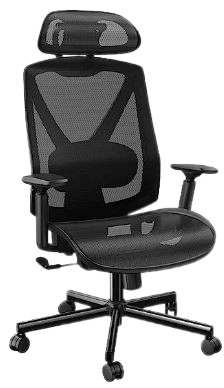
As someone on a budget looking for wider upper back and neck support, the HUANUO Office Chair proved to be a great option. The mesh headrest was a standout feature, offering more adjustability than other higher-priced chairs. I could easily raise or lower the headrest to suit my height and posture, providing excellent support for my upper back and neck.
The mesh back with fixed lumbar support and arms complemented the articulated headrest, creating a comfortable and ergonomic design. The tilt with tension control allowed me to lock the chair at any desired angle, and the 125-degree backrest tilt was a pleasant addition, offering flexibility during work hours.
While being a budget chair, it did require some compromises. The armrests were 2D adjustable. However, I found that the overall comfort level was more than sufficient for short-term sitting sessions.
Overall, the HUANUO Office Chair offers remarkable neck support for those on a tight budget. Its adjustable headrest and comfortable design make it a worthy contender, even compared to higher-priced alternatives. Despite a few minor drawbacks, it serves its purpose well and provides a budget-friendly solution for upper back and neck pain.
7. Duwin Ergonomic Chair For Neck And Shoulder Pain
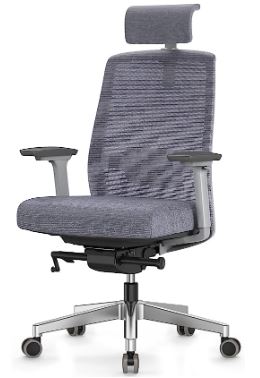
After extensively researching chairs for neck and shoulder pain relief, I came across the Duwin Ergonomic Chair, and it turned out to be a great find.
The Duwin chair didn’t disappoint. It provided great comfort and back support, which was crucial for me due to a weak back from a previous operation. The gas lift, adjustable neck support, and the option to lock the backrest for extra comfort or adjust it to recline made it a highly customizable and ergonomic choice.
The incline feature of the lumbar support was precisely what I needed for long hours at my desk, and I was in awe of how comfortable it felt. The chair’s numerous adjustments and padded back support made it stand out from other options, which often had plastic backrests.
See the picture below of our first-hand experience, with package arrival at home.
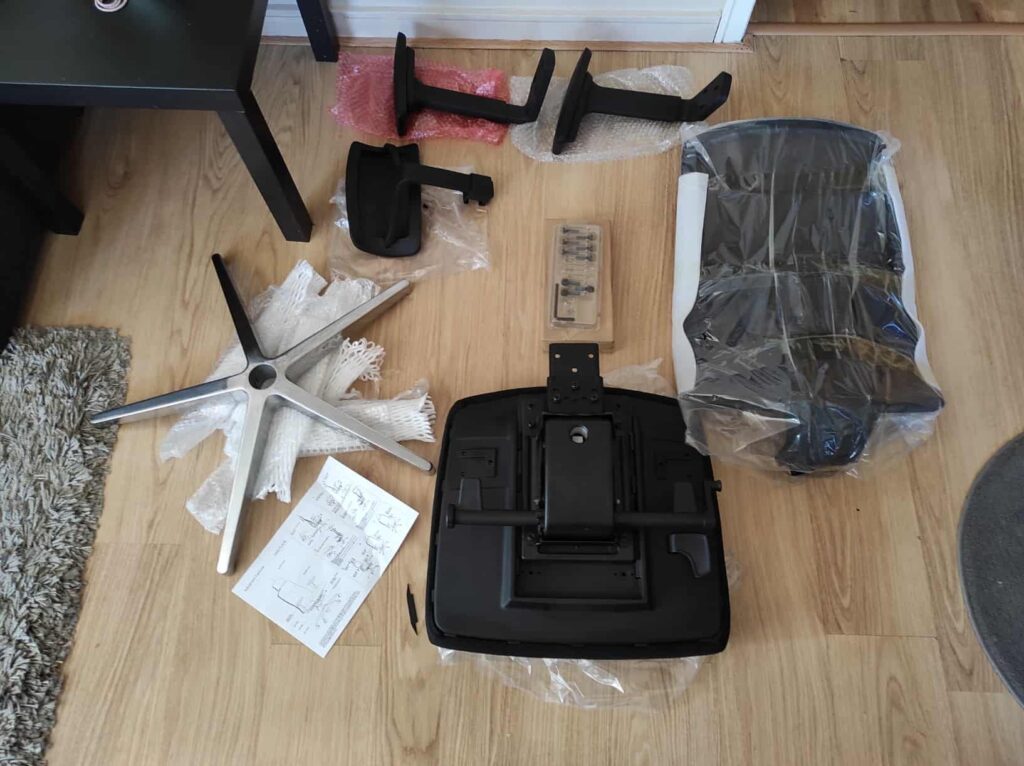
While I had to buy additional memory foam for the elbow pads to make them more comfortable for prolonged use, the overall experience with the Duwin Ergonomic Chair was excellent. The chair’s functionality and features, usually found in higher-priced models, made it well worth the purchase. If you’re looking for a supportive and comfortable chair for neck and shoulder pain, the Duwin Ergonomic Chair is definitely worth considering.
How We Test
When testing for the best office chair for neck and shoulder pain problems, our approach focuses on investigating the effectiveness of the headrest in alleviating neck discomfort and the overall support provided to address shoulder pain.
For neck pain, we examine the headrest’s design and adjustability. We test the headrest’s ability to provide proper support to the neck and upper spine, ensuring it promotes a natural and comfortable alignment. We also evaluate the headrest’s material, looking for breathable and soft fabrics that prevent sweating and irritation during prolonged use.
To address shoulder pain, we assess the chair’s overall back support. We evaluate the chair’s ability to maintain proper alignment, preventing strain on the shoulders and upper back. Additionally, we consider the armrests’ adjustability, as improperly positioned armrests can contribute to shoulder discomfort.
During testing, we gather feedback from users with neck and shoulder pain issues to assess the chair’s effectiveness in providing relief and reducing discomfort during extended periods of sitting. Our focus is on identifying chairs that excel in both headrest support for neck pain and overall back support for shoulder pain, ensuring that users can work comfortably and productively without exacerbating their pain problems.
Best Office Chair For Neck And Shoulder Pain Problems: FAQ’s
How can I prevent upper back pain while working?
One of the key preventive measures for upper back pain at work is maintaining excellent posture throughout the day. This applies whether you’re sitting, standing, or in motion.
What are some tips for maintaining good Position?
When standing, make sure to distribute your weight evenly on both feet and keep a balanced position. When lifting or carrying items, approach them closely, bend your knees, and engage your core muscles to support your back.
How does prolonged sitting contribute to upper back pain?
Extended periods of sitting can lead to bad posture, reduced blood flow, and increased pressure on the neck and upper back. This can contribute to discomfort and pain over time.
Are there specific exercises that can help prevent upper back pain?
Yes, regular stretching exercises targeting the arms, upper back, and neck muscles can be beneficial. Examples include neck rolls, shoulder shrugs, shoulder rolls, and stretches like the “butterfly wings” pose that promote a chest-out, shoulders-back stance.
How can ergonomic chairs help prevent upper back pain?
Investing in an ergonomic chair that can be customized to your needs can significantly reduce upper back discomfort. These chairs provide comprehensive back support, including support for the neck, lumbar spine, and upper back, creating a more comfortable and supportive work environment.
What are some strategies for managing upper back pain while sitting in an office chair?
Effective management of upper back pain in an office chair begins with paying attention to good posture and ergonomic principles. These factors play a crucial role in reducing discomfort and strain.
How can I adjust my office chair for better support and comfort?
Start by adjusting your ergonomic chair to accommodate your natural spinal curvature. Ensure that the chair’s lumbar support is inflatable to maintain a natural ‘S’ shape in your back, avoiding extremes of flatness or exaggerated curvature.
What should I consider regarding my workstation setup to reduce upper back pain?
Position your monitor at eye level to prevent straining your neck and upper back. Adjust the chair’s back height and tension to match your own back height and preferences, respectively. Maintain a seating position that fully engages the backrest and avoids slouching or leaning to one side.
Are there specific guidelines for sitting posture to alleviate upper back pain?
Yes, follow ergonomic recommendations such as keeping your hands at a 90-degree angle on the work table, ensuring your head is level, and keeping your upper arms parallel to your spine. Keep your feet flat on the floor, legs uncrossed, and pelvis in an “open” position at a 90-degree angle for stability and comfort.
What key features should I seek in an office chair to effectively alleviate upper back pain?
When seeking relief from upper back pain, it’s crucial to look for office chair features that provide comprehensive support to your entire upper back, including the top of your shoulders. A backrest that is narrower at the top promotes an “open chest” posture, preventing a hunched position that can exacerbate pain. Consider chairs with an inflatable thoracic support, such as a ‘V’ shaped cushion in the upper backrest, which is height adjustable and increases contact with the upper spine by filling the space between the shoulder blades. This feature helps prevent slouching, reduces discomfort in the upper back, shoulders, and neck, and contributes to better posture overall.

